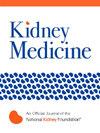急性肾损伤后使用肾素-血管紧张素抑制剂对长期死亡率和主要肾脏不良事件的影响:一项5年回顾性观察队列研究
IF 3.4
Q1 UROLOGY & NEPHROLOGY
引用次数: 0
摘要
基本原理及目的急性肾损伤(AKI)在住院成人中很常见,是慢性肾脏疾病和死亡的危险因素。急性肾损伤后血管紧张素转换酶抑制剂(ACEi)或血管紧张素受体阻滞剂(ARBs)对死亡率和长期肾功能的影响尚不清楚。研究设计倾向加权回顾性观察队列研究。设置,2015年11月至2016年10月,共有3289名AKI患者入住三级医院,随访至2020年9月。aki后180天内使用acei /ARB。结果:全因死亡率和主要肾脏不良事件(MAKE),由aki后肾脏替代治疗的综合定义,持续估计肾小球滤过率(eGFR)较基线下降30%,或eGFR≤15 mL/min/1.73 m2。我们根据年龄、性别、合并症、既往用药、重症监护病房入院、严重败血症和AKI肾病指数(AKI肾病:改善全球结局严重程度),生成AKI后ACEi/ARB使用的倾向权重。Cox比例风险模型用于检验aki后ACEi/ARB与死亡率、MAKE和eGFR斜率联合模型的相关性。结果随访结束时,共有2309例(70.2%)患者死亡或发生MAKE。分别有161例(4.9%)和406例(12.3%)患者在aki后180天内开始或恢复先前使用ACEi/ARB。尽管整个队列的死亡率与AKI后ACEi/ARB的使用没有显著相关性,但在KDIGO - 3型AKI患者中观察到与较低的死亡率显著相关(HR, 0.40;95% ci, 0.21-0.75;p交互作用= 0.003)。然而,aki后使用ACEi/ARB与无心血管适应症的ACEi/ARB患者的MAKE增加相关(HR, 1.52;95% ci, 1.17-1.98;p交互作用= 0.03)。尽管aki后使用ACEi/ARB与急性eGFR下降相关(初始eGFR变化- 2.3 mL/min/1.73 m2/年;95% CI,−3.1 ~−1.5;P & lt;0.001),与长期eGFR下降无关联。局限性:对异质性AKI队列进行回顾性观察研究,没有ACEi/ARB累积暴露的数据。结论早期ACEi/ARB与KDIGO - 3型AKI患者更好的长期生存或肾功能无关,但与较低的死亡率相关。急性肾损伤(AKI)在住院成人中很常见,并增加死亡和肾衰竭的风险。尽管血管紧张素转换酶抑制剂(ACEi)或血管紧张素受体阻滞剂(ARBs)已广泛用于蛋白尿肾病以减缓肾功能下降,但aki后使用ACEi/ARB对长期肾功能的影响尚不清楚。在这项为期5年的3289例AKI患者的研究中,我们发现,尽管患者在肾损伤后早期开始使用ACEi/ARB后肾功能出现短暂性下降,但这些患者的长期肾功能轨迹和生存率与未早期使用ACEi/ARB的患者相似。然而,在AKI后使用ACEi/ARB可能会降低严重AKI患者的长期死亡风险。此外,我们注意到在aki后早期无心血管适应症的ACEi/ARB患者亚组中持续肾功能恶化。这些观察结果表明,临床医生应该采用更个性化的方法在aki后早期给药ACEi/ARB。本文章由计算机程序翻译,如有差异,请以英文原文为准。
Effect of Post-Acute Kidney Injury Use of Renin-Angiotensin Inhibitors on Long-term Mortality and Major Adverse Kidney Events: A 5-year Retrospective Observational Cohort Study
Rationale & Objective
Acute kidney injury (AKI) is common in hospitalized adults and a risk factor for chronic kidney disease and mortality. The effect of angiotensin-converting enzyme inhibitors (ACEi) or angiotensin receptor blockers (ARBs) post-AKI on mortality and long-term kidney function remains unclear.
Study Design
Propensity-weighted retrospective observational cohort study.
Setting & Participants
A total of 3,289 patients with AKI admitted to a tertiary care hospital from November 2015-October 2016, with follow-up until September 2020.
Exposures
ACEi/ARB use within 180 days post-AKI.
Outcomes
All-cause mortality, and major adverse kidney events (MAKE) as defined by composite of renal replacement therapy post-AKI, sustained estimated glomerular filtration rate (eGFR) decline >30% from baseline, or eGFR ≤15 mL/min/1.73 m2.
Analytical Approach
We generated propensity weights for ACEi/ARB use post-AKI, using age, sex, comorbid conditions, prior medication, intensive care unit admission, severe sepsis, and index AKI Kidney Disease: Improving Global Outcomes severity. Cox proportional hazard models were used to test associations of post-AKI ACEi/ARB with mortality, MAKE, and joint models for eGFR slopes.
Results
A total of 2,309 (70.2%) participants died or experienced MAKE by end of follow-up. 161 (4.9%) and 406 (12.3%) patients initiated or resumed prior ACEi/ARB use within 180 days post-AKI, respectively. Although the overall cohort had no significant mortality association with post-AKI ACEi/ARB use, a significant association with lower mortality was observed in patients with KDIGO 3 AKI (HR, 0.40; 95% CI, 0.21-0.75; Pinteraction = 0.003). However, post-AKI ACEi/ARB use was associated with increased MAKE in patients without cardiovascular indications for ACEi/ARB use (HR, 1.52; 95% CI, 1.17-1.98; Pinteraction = 0.03). Although post-AKI use of ACEi/ARB was associated with acute eGFR decline (initial eGFR change −2.3 mL/min/1.73 m2/year; 95% CI, −3.1 to −1.5; P < 0.001), no association with longer-term eGFR decline was observed.
Limitations
Retrospective observational study on heterogeneous AKI cohort without data on ACEi/ARB cumulative exposure.
Conclusions
Early ACEi/ARB post-AKI was not associated with better long-term survival or kidney function but was associated with lower mortality in patients with KDIGO 3 AKI.
Plain Language Summary
Acute kidney injury (AKI) is common in hospitalized adults and increases the risk of death and kidney failure. Although angiotensin-converting enzyme inhibitors (ACEis) or angiotensin receptor blockers (ARBs) have been widely used in proteinuric kidney disease to slow kidney function decline, the effect of ACEi/ARB use post-AKI on long-term kidney function remains unclear. In this 5-year study of 3,289 patients with AKI, we found that although patients experienced a transient decrease in kidney function following early ACEi/ARB initiation after their kidney injury, long-term kidney function trajectory and survival in these patients were similar to patients without early ACEi/ARB use. However, ACEi/ARB use after an AKI may reduce the long-term risk of death in patients with severe AKI. Additionally, we noted sustained kidney function deterioration in a subgroup of patients on ACEi/ARB early post-AKI in the absence of cardiovascular indications. These observations suggest that clinicians should adopt more individualized approaches to early ACEi/ARB administration post-AKI.
求助全文
通过发布文献求助,成功后即可免费获取论文全文。
去求助

 求助内容:
求助内容: 应助结果提醒方式:
应助结果提醒方式:


